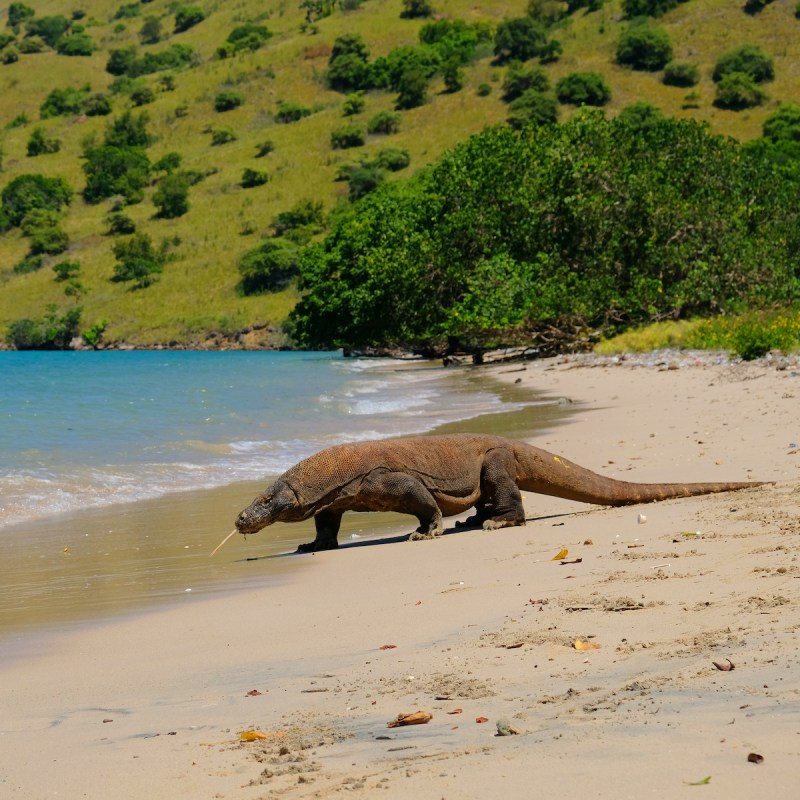
One of the highlights of any trip to Indonesia is a trek to see the Komodo dragons — the world’s largest and heaviest lizards. Now, however, the price to see those lizards in the wild is 25 times more expensive than it was last week.
Videos by TravelAwaits
Earlier this week, Indonesia’s government increased the fee to visit Komodo and Padar Islands in Komodo National Park, where the giant lizards live, from 150,000 rupiah to 3.75 million rupiah ($252). The government also capped the number of visitors to Komodo National Park at 200,000 people per year.
The fee and visitor limit are part of the government’s plan to protect the Komodo dragons from over-exposure to humans while also protecting the park itself as part of an ongoing conservation effort.
“We want conservation, but we also want [to increase] the economy through tourism, through tourist visits,” President Joko “Jokowi” Widodo said, according to Jakarta Globe. “These two must be balanced.”
It’s important to note, however, that while the rules apply to Komodo and Padar Islands within the park, they do not apply to Rinca Island.
“So, if you want to see Komodo dragons, please go to Rinca. There are Komodo dragons there. How much does it cost? The same as before,” Widodo said. “If you say, ‘Wait, I really want to see the ones on Komodo Island,’ that’s okay too, but you’ll pay the new fee.”
What You Need To Know About Komodo Dragons
Komodo dragons, which have lived in Indonesia’s Lesser Sunda Islands for millions of years, are not only the world’s largest and heaviest lizards, but they also are one of the few with a venomous bite. They can reach lengths of up to 10 feet and weigh up to 330 pounds, according to National Geographic.
Although Komodo dragons can run at speeds up to 13 miles per hour, they are quiet hunters, preferring to find or ambush prey, according to Smithsonian’s National Zoo & Conservation Biology Institute.
Komodo dragons, sometimes called Komodo monitors, are “stealthy, powerful hunters that rely on their sense of smell to detect food, using their long, forked tongues to sample the air,” Smithsonian’s National Zoo & Conservation Biology Institute explains. “They can spend hours waiting for a sizable meal to wander within range before launching a deadly attack with their large, curved and serrated teeth.”
The lizards eat almost any kind of meat, scavenging for carcasses or stalking animals that range in size from small rodents to deer and even large water buffalo.
Where You’ll Find Komodo Dragons
Komodo National Park, in the Lesser Sunda Islands of Indonesia, is located along the border between East Nusa Tenggara and West Nusa Tenggara provinces. The 700-square-mile park is made up of 29 different islands, and Komodo, Padar, and Rinca are the largest. The islands, which developed after volcanic activity, are known for their rugged hills reaching heights of 2,411 feet.
Komodo National Park was created by the Indonesian government in 1980 to protect the Komodo dragon, according to WWF, the World Wide Fund For Nature. The park was then named a UNESCO World Heritage site in 1991.
More than 1,000 species of tropical fish and 260 species of coral can be found in the park’s waters, as well as seven species of sharks including hammerhead sharks and gray reef sharks. Marine mammals such as whales and dolphins are also frequently spotted in the waters.
On land, visitors can find deer, boar, buffalo, and the ubiquitous Komodo dragon. Approximately 1,700 Komodo dragons live on Komodo Island while just about 1,300 live on Rinca Island, according to World Atlas.
Fears Of A Devastating Impact On Tourism
The government’s abrupt change of fees and cap on visitation numbers has not been received well by those working in Indonesia’s tourism industry. In fact, more than 700 local workers who depend on tourism for a living immediately went on strike.
“We have agreed to stop all types of tourism services in the National Park Islands and all tourist destinations in West Manggarai from August 1 through 31, 2022,” Rafael Taher, the Coordinator of West Manggarai’s Tourism Service Providers, said, Jakarta Globe reports.
Under terms of the strike agreement, owners of tour guides, boats, car and motorcycle rentals, hotels, restaurants, and food stalls will be closed during the strike.
“This has caused uncertainty among us,” said Leo Embo, a tour guide, according to CNN. “We decided to go on strike even when we’re suffering from a loss here. This might as well be suicide.”
Nonetheless, Sony Zeth Libing, who leads the East Nusa Tenggara Provincial Tourism Office, said the government will stick to implementing the national park entrance fee increase despite the strike.
“The East Nusa Tenggara Provincial Government appreciates the aspirations of the people who reject the increase in entrance tickets of 3.75 million to Komodo Island and Padar Island,” Sony said, according to Jakarta Globe. “We are reviewing all these aspirations, but of course, the application of new tariffs for entry to Komodo will still be carried out because it has already passed thorough study.”
Sony went on to add “We have to anticipate [damage to ecosystem] early before a wider problem occurs in the Komodo habitat and its ecosystem.”
